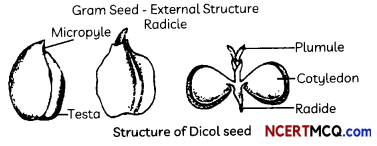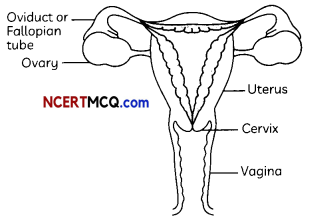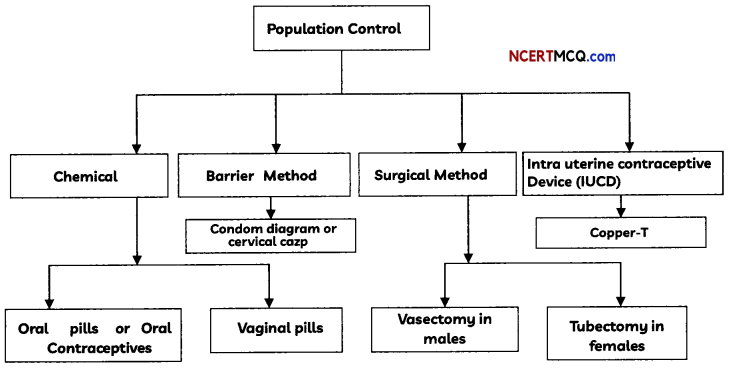Sexual Reproduction
Sexual reproduction is a type of reproduction in which the two sexes, namely, male and female are involved. It incorporates a process of combining DNA from two different individuals during reproduction.
DNA Content Re-establishment in New Generation
- The gametes (or reproductive cells) contain only half the number of DNA (or half the number of chromosomes) as compared to the normal body cells.
- The germ cell that is large and contains the food stores is called the female gamete.
- The gamete that is smaller and motile is called the male gamete.
- When a male gamete combines with a female gamete during sexual reproduction, the zygote formed will have the same number of DNA as present in the organism.
Significance of Sexual Reproduction
- It promotes the diversity of characters in the offspring.
- It Leads to variations which is necessary for evolution.
- It plays an important role in the origin of new species.
![]()
Example 1.
What are the advantages of sexual reproduction over asexual reproduction?
Answer:
As sexual reproduction involves two parents, the newly formed individual has characteristics of both the parents. More variations are produced in sexual reproduction as it involves two parents. Thus, it ensures the survival of species in a population.
Sexual Reproduction in Plants
- The reproductive ports of angiosperms are located in the flower.
- Stamens and carpeLs are the reproductive parts of a flower which contain the germ ceLLs.
- Stamen is the male reproductive port and produces pollen grains.
- Carpet is the female reproductive part and contains the ovary, style and stigma.
- Some flowers are unisexuaL such os papaya and watermelon whiLe some are bisexual such ashibiscus and mustard.
- Unisexual flowers contain either stamens or carpels.
- Bisexual flowers contain both stamens and carpels. Majority of the flowers are bisexual.
- The various parts of a flower are:
Sepals: These are usually green in colour.
Petals: These are coloured.
Stamen: It is the male reproductive part of a flower and consists of a stalk called filament and a flattened top called the anther. The anthers produce the pollen grains. Each pollen grain produces two male gametes.
Carpel: It is the female reproductive part of a flower and consists of a swollen ovary at the base, an elongated middle style and a terminal stigma. The ovary contains ovules and each ovule has an egg.
Pollination
The transfer of pollen grains from another to stigma is called pollination. The transfer of pollen grains is carried out by several agents such as water, wind, insects and other agencies.
Pollination is of two types-self pollination and cross-pollination.
| Self-Pollination | Cross Pollination |
| 1. The transfer of pollen grains from the anther of a flower to the stigma of the same flower or another flower of the same plant. | 1. The transfer of pollen grains from the anther of a flower to the stigma of another flower of a different plant of the same species. |
| 2. It occurs in flowers which are genetically same. | 2. It occurs between flowers which may be genetically different. |
| 3. Self-pollination increases genetic uniformity and decreases variations. | 3. Cross-pollination decreases genetic uniformity and increases variations. |
| 4. Does not require pollinators for transfer of pollen grains. | 4. Requires pollinators for transfer of pollen grains. |
![]()
Fertilization in Plants
- Pollination, i.e., transfer of pollen grains from anther of a flower to stigma takes place.
- Pollen grains which are deposited on the stigma form tubes called pollen tubes.
- One pollen tube grows through the style and reaches the ovary where the ovules are located.
- The pollen tube normally enters the ovule through a small opening called micropyle.
- Inside the ovule, the pollen tube releases two male gametes into the embryo sac which contains the egg.
| Pollination | Fertilization |
| 1. Pollination is the process of transferring of pollen from stamen to the stigma of a flower. | 1. Fertilization is the fusion of male gametes and female gametes of plants |
| 2. It precedes fertilization | 2. It takes place only after pollination has taken place. |
Double fertilization: Inside each embryoac, two fusions, syngamy and triple fusion take place and this mechanism of two fusions occurring in an embryo sacis called double fertilization.
Syngamy: The fusion of one male gamete with the female gamete (egg) inside the embryoac is called syngamy and it results in zygote,
- After fertilization, the zygote divides several times to form an embryo within the ovule.
- The ovule develops a tough coat and is gradually converted into a seed.
Germination
The process by which the seed, which contains the future plant or embryo, develops into a seedling under appropriate conditions.
- The ovary grows rapidly and ripens to form a fruit.
- The petals, sepals, stamens, style and stigma shrivel and fall off.
Example 2.
Case Based:
Soak a few seeds of Bengal gram (chana) and keep them overnight. Drain the excess water and cover the seeds with a wet cloth and leave them for a day. Make sure that the seeds do not become dry. Cut open the seeds carefully and observe the different parts.
(A) Select the correct observations:
(I) One massive and fleshy cotyledon can be seen.
(II) It has a small pore called the micropyle at the pointed end.
(III) The plumule is the future root.
(IV) The radicle is the future root.
(a) Both (I) and (II)
(b) Both (I) and (III)
(c) Both (II) and (III)
(d) Both (II) and (IV)
Answer:
(A) (d) Both (II) and (IV)
Explanation: Gram seed has two cotyledons. Just below the hilum lies the micropyle in the form of a small pore. Water is absorbed through the micropyle during the germination of seed. The plumule is the future shoot and radicle is the future root.

(B) During the germination of seeds, the seed coat ruptures due to
(a) massive imbibition of water
(b) differentiation of cotyledons
(c) a sudden increase in cell division
(d) massive glycolysis in cotyledons and endosperm
Answer:
(a) massive imbibition of water
Explanation: During the germination of seeds, the seed coat ruptures due to massive imbibition of water through the micropyle.
(C) Name the part of the seed through which water enters the seed.
Answer:
The part of seed through which water enters the seed is the micropyle.
(D) Name the part of the flower which develops into seed and fruit respectively.
Answer:
The ovule develops a tough coat and is gradually converted into a seed. The ovary grows rapidly and ripens to form a fruit.
(E) Assertion (A): The seed of a plant contains the future plant or embryo.
Reason (R): The ovary of the flower grows rapidly and ripens to form a fruit.
(a) Both (A) and (R) are true and (R) is the correct explanation of the assertion.
(b) Both (A) and (R) are true, but (R) is not the correct explanation of the assertion.
(c) (A) is true, but (R) is false.
(d) (A) is false, but (R) is true.
Answer:
(b) Both (A) and (R) are true, but (R) is not the correct explanation of the assertion.
Explanation: After fertilization, the zygote divides several times to form an embryo within the ovule. The ovule develops a tough coat and is gradually converted into a seed.
Human Reproductive System
The structures associated with reproduction are different in males and females.
![]()
Puberty
Puberty is the age in the life of human beings when the reproductive tissues begin to mature and the reproductive system becomes functional. It is 13 to 14 years for males and 10 to 12 years for females. Some changes begin to take place in both girls and boys during this period.
- Changes such as thicker hair in armpits and genital area between the thighs, thinner hair on legs and arms, oily skin and development of pimples are common to both girls and boys.
- However, there are also changes that are different between boys and girls. For example, increase in breast size, darkening of the skin of the nipples and beginning of menstruation are some of the changes observed in girls. Thick hair growth on the face, cracking of voice, and penis occasionally getting erect and enlarged are some of the changes observed in boys.
Role of Hormones: The testes and ovaries produce viable gametes and also secrete hormones.
- The testis secretes the male hormone testosterone and the ovary secretes the female hormone estrogen.
- Hormones regulate the process of gametogenesis (formation of gametes).
- Hormones maintain the structure and function of accessory sex organs
- Hormones develop secondary sex characters like facial, axial and pubic hair, pitch of the voice and development of mammary glands.
Male Reproductive System

The human male reproductive system consists of the following organs:
- Testes: The primary male reproductive organ is a pair of testis which lies in a sac-like muscular structure outside the abdominal cavity called scrotum. The formation of germ-cells or sperms takes place in the testes. It secretes the male hormone testosterone, which regulates the formation of sperms and brings about changes in appearance in boys.
- Scrotum: It provides an optimal temperature for formation of sperms which is 1- 3° C lower than the body temperature.
- Vas deferens: It is a long tube which arises from each testes and which carries sperms into organs called seminal vesicles, where the sperms get nourished and stored.
- Urethra: It is a common passage for the passage of both urine and spermatic fluid. The vas deferens unites with a duct coming from the urinary bladder to form urethra.
- Penis: It forms the external male genital organ and is a thick muscular organ which encloses the urethra. There is only one opening for the urine and sperms.
![]()
Example 3.
What is the role of the seminal vesicles and the prostate gland?
Answer:
Seminal vesicles and the prostate gland form the part of the accessory glands, which are associated with the male reproductive system. Seminal vesicles and prostate gland secrete a fluid which makes the transport of sperms eas-ier along the path of urethra and at the same time provides nutrition to the sperms.
Female Reproductive System

The human female reproductive consists of the following organs:
1. Ovaries: There is a pair of small and oval-shaped organs, located in the abdominal cavity near the kidney. Ovaries are the female primary reproductive organs which perform dual functions of production of female gamete or ovum and the secretion of female sex hormones, estrogen and progesterone. Each ovary is composed of ovarian follicles and these follicles undergo maturation at puberty to produce ova.
2. Fallopian tube or Oviduct: These are a pair of long convoluted tubes that carry ova or eggs from the ovary to the uterus. The fallopian tube has a funnel-shaped opening near the ovary. These tubes from both the sides open into a muscular structure, the uterus.
3. Uterus or womb: It is a hollow, pear-shaped organ within which the embryo develops. Its upper portion is broader, while its lower portion is narrower, called cervix.
4. Vagina: The cervix opens into the vagina which is a tubular structure and also called “birth canal’’. Vagina receives sperms from the male and also serves as the passage through which the fully developed foetus is born.
Sexual cycle in females: When the human females attain the age of puberty, the ovaries exhibit a cycle of events at definite intervals which are described below:
- The ovarian follicle grows into mature follicle.
- One mature follicle develops to surround one ovum.
- The maturing ovum is from one of the two ovaries.
- Ovulation: The ovum is then released from the respective ovary by the process called ovulation.
- As the ovarian follicles mature, the inner wall of uterus thickens to get prepared for receiving the developing zygote in case fertilization occurs.
- In case fertilization does not take place, the thick-ened inner wall of the uterus breaks down along with its blood vessels and moves out of the vagina in the form of bleeding, called menstrual flow which lasts for 4 – 7 days.
- Menstrual Cycle: The cycle of events taking place in the ovaries and uterus every twenty-eight days and marked by the menstrual flow is called the menstrual cycle or sexual cycle in the human female.
- Menstruation occurs every 28 to 30 days and ovulation takes place in the mid of the menstrual cycle around 14th day.
- Both ovulation and menstruation stops temporarily when the women gets pregnant till birth of the offspring.
- Menarche: The commencement of menstruation at puberty is called menarche and marks the beginning of the reproductive life of a woman.
- Menopause: The stoppage of menstrual flow and other events around the age of 50 years in human females is called menopause.
Fertilization
- The fertilization in human beings is internal.
- It takes place if copulation has taken place during ovulatory period, i.e., the middle of the menstrual cycle.
- It takes place in the fallopian tube where only one sperm out of the millions of sperms released in the vagina fertilizes the ovum.
- Fertilization is marked by the absence of menstrual flow.
- Zygote is formed after the union of the sperm and the ovum.
- This marks the beginning of pregnancy, i.e., the embryonic development of zygote starts in the fallopian tube.
- Implantation: After fertilization has taken place, the embryo moves down to reach the uterus and gets attached to its thickened wall and this close attachment of the embryo with the uterus is called implantation.
- Placenta: It is a special tissue that develops between uterine wall and the embryo after implantation and through which the development needs of the foetus are met from the mother’s body. This is a disc which is embedded in the uterine wall. It contains villi on the embryo’s side of the tissue and blood spaces surrounding the villi on the mother’s side. This provides a large surface area for glucose and oxygen to pass from the mother to the embryo. The waste substances generated by the developing embryo is also removed through the placenta.
Example 4.
Why does menstruation occur?
Answer:
In female reproductive system, the ovary releases one egg every month, during the same period, the uterus also prepares itself to receive a fertilised egg. Thus its lining becomes thick and spongy. This would be required for nourishing the embryo if fertilisation had taken place.
If the egg is not fertilised, it lives for about one day and then it is lost. The lining earlier formed to receive the fertilised egg, is not needed any longer. So, the lining slowly breaks and comes out through the vagina as blood and mucous. This cycle takes place roughly every month and is known as menstruation. It usually lasts for about two to eight days.
Reproductive Health
Reproductive health is important as the process of sexual maturation is gradual and making choices can become very diffcultdue to pressures from friends, family or government agencies. Also, many diseases can be transmitted sexually as the sexual act is a very intimate connection of bodies.
Sexually Transmitted Diseases (STDs): These are the diseases that are spread from an infected person to a healthy person by sexual contact. These include bacterial infections such as gonorrhoea and syphilis, and viral infections such as warts and HIV-AIDS.
![]()
Population Control
A number of techniques have been developed to prevent and manage pregnancy as frequent pregnancies have an adverse effect on the health of a woman. These methods are described below:


Effects of contraceptives:
- Since oral pilLs change the hormonaL balance of the body so that eggs are not released and fertilization does not occur and hence can cause side-effects.
- Loop or copper-T are placed in the uterus to prevent pregnancy and can cause irritation of the uterus.
- Surgical methods are safe in the long run but they can cause infections and other problems if not performed properly.
Advantages of adopting contraceptive methods :
- Avoiding frequent and unwanted pregnancy
- Keeping population and hence birth rate under control
- Helps in keeping proper gap between two preg-nancies.
- Helps in preventing the spread of sexually transmitted diseases.
- Helps in improving the reproductive health of women.
Female Foeticide: Surgical methods can be used for removal of unwanted pregnancies and hence can be misused by people who do not want a particular child. Female foeticide is the illegal sex-selective abortion of female foetuses due to which child sex ratio is declining at an alarming rate.